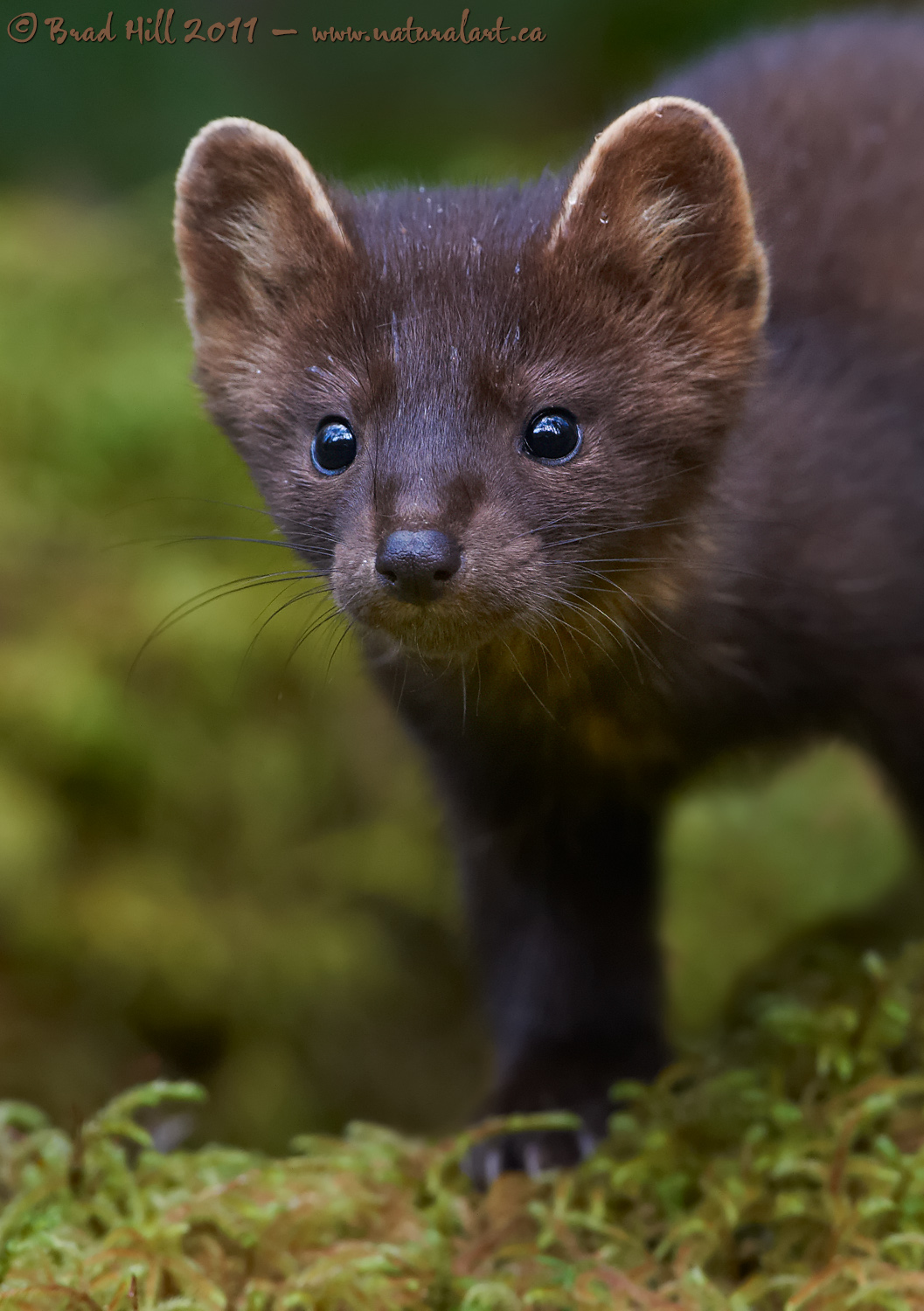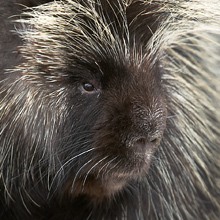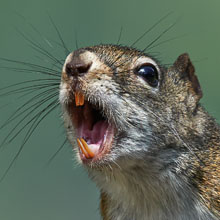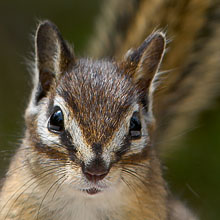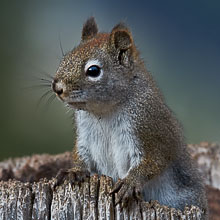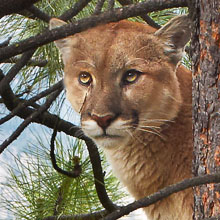Availability: Undetermined - Enquiries?
In the Field
The Original Cute Little Devil! Great Bear Rainforest (northern BC Coast), BC, Canada. October 9, 2011.
This is a shot that illustrates very well how - if you're not careful - nature can really throw you a curve. One would be hard-pressed to find a cuter animal anywhere on the planet than the American Marten - between their huge ears, inky black eyes, button nose, huge whiskers, and almost perfectly triangular head these little guys are the absolute living embodiment of the word "cute"! But the cuteness belies their true nature - these coldly efficient little carnivores sport amazingly sharp teeth and they're lightning quick. In short, to mice and squirrels these cuties are simply well-disguised little devils! Like most species of wildlife, under normal circumstances one could never get close enough to one to pet it (and I'm almost ashamed that the natural reaction of almost all non-habituated wildlife is to fear and flee from all humans), but if you did you'd be well advised to count your fingers shortly thereafter! ;-)
This image is nothing more than a lucky "grab" shot. I captured it while leading a photo tour into the Great Bear Rainforest in the autumn of 2011. At the time we were in a viewing stand where Spirit Bears (as well as black-coloured black bears) are known to visit. I had just taken my camera (and 600mm lens) off of a tripod when someone noticed this CLD (Cute Little Devil) trotting down a angled moss-covered fallen log that was at eye level (when looking out the back of the viewing stand). My camera was still in my hand and I had only enough time to raise it up, focus, and snap off a few shots using whatever settings my camera's controls were adjusted to (I had ZERO time to change anything!). I suppose one could argue that my ability to hand-hold a very bulky lens and how I set up the Auto-ISO function on my camera both contributed to the success of the image capture, but the reality is that I was really just darned lucky!
In a perfect world (i.e., the one I don't live in) this image would have a greater depth-of-field - I'd like it a whole lot more if the foreground was in focus (but with the background pleasingly blurred), but I can take some solace in the fact that the bits most necessary to illicit the "cute" response - the sensory organs of the head (the eyes, nose, whiskers and the ears) - are either sharply focused or, in the case of the ears, mostly in focus! ;-)
ADDITIONAL NOTES:
NOTE 1: This image - in all resolutions - is protected by copyright. I'm fine with personal uses of it (including use as desktop backgrounds or screensavers on your own computer), but unauthorized commercial use of the image is prohibited by law. Thanks in advance for respecting my copyright!
NOTE 2: Like all wildlife images on this website, the subject(s) is/are fully wild and completely unconstrained. Besides the potential impact of my/our presence, nothing has been done to intentionally alter or affect the ongoing behavior of the subject and, of course, there has been no use of any form of bait or other form of wildlife attractants/luring devices (including vocalizations or other sounds).
NOTE 3: This image was captured during one of my "Into the Great Bear Rainforest" photo tours in the autumn of 2011. Each year I offer trips into two different parts of the Great Bear Rainforest as well as one to photograph aquatic mammals and oceanscapes near the northern tip of Vancouver Island. And, in selected years, I also offer photo tours to locations to capture other highly sought-after subjects, such as various owl species of the boreal forest and wildlife of Canada's Arctic. Details about these trips can be found on the Photo Tours page of this website.
Behind the Camera
The Original Cute Little Devil! Great Bear Rainforest (northern BC Coast), BC, Canada. October 9, 2011.
Digital Capture; Compressed RAW (NEF) 14-bit format; ISO 3200
Nikon D3s with Nikkor 600mm f4G VR lens - handheld. VR on and in "Normal" mode.
1/400s @ f5.6; -0.67 stop compensation from matrix-metered exposure setting.
At the Computer
The Original Cute Little Devil! Great Bear Rainforest (northern BC Coast), BC, Canada. October 9, 2011.
RAW Conversion to 16-bit TIFF, including first-pass/capture sharpening using Phase One's Capture One Pro 6. Three exposure variants covering a 0.9 stop total range.
Further digital corrections on 16-bit TIFF file using Adobe's Photoshop CS5 and Light Craft's LightZone. Photoshop adjustments including compositing (layering and masking) the exposure variants and sharpening for web output. Final contrast/tone tweaking - particularly to mid-tones - performed with LightZone using the tonemapper/re-light tool.
Conservation
The Original Cute Little Devil! Great Bear Rainforest (northern BC Coast), BC, Canada. October 9, 2011.
Ten percent of the revenue generated by this image will be donated to Raincoast*.
Species Status in Canada**: Newfoundland population Threatned; other populations within Canada not listed as Endangered, Threaten, or of Special Concern.
The American Marten (Martes americana) is a smallish tree-dwelling carnivore and a member of the weasel family (family Mustelidae). They possess a long silky and dense fur that has been coveted by the fur-trade industry for many decades (and earned the Marten the nickname "The American Sable"). In Canada and the bulk of North America Martens are normally associated with mature (old growth) coniferous and mixed-wood forests.
This American Marten was photographed in a region on the coast of BC known as the Great Bear Rainforest. This region is, at the time of this writing (October 25, 2011), facing a new and potentially catastrophic threat. There is a proposal to bring oil super-tankers through the narrow and treacherous channels of the Great Bear Rainforest. Any mishap - such as the one that sunk the Queen of the North ferry on March 22, 2006 - could result in an oilspill with disasterous consequences.
*The Raincoast Conservation Society (and Foundation) is an effective and efficient organization that has been fighting for protection of this unique habitat. If you are looking for a meaningful way to contribute to the conservation of this amazing ecosystem, Raincoast will provide maximal "bang" for your conservation dollars.
**as determined by COSEWIC: The Committee on the Status of Endangered Wildlife in Canada












